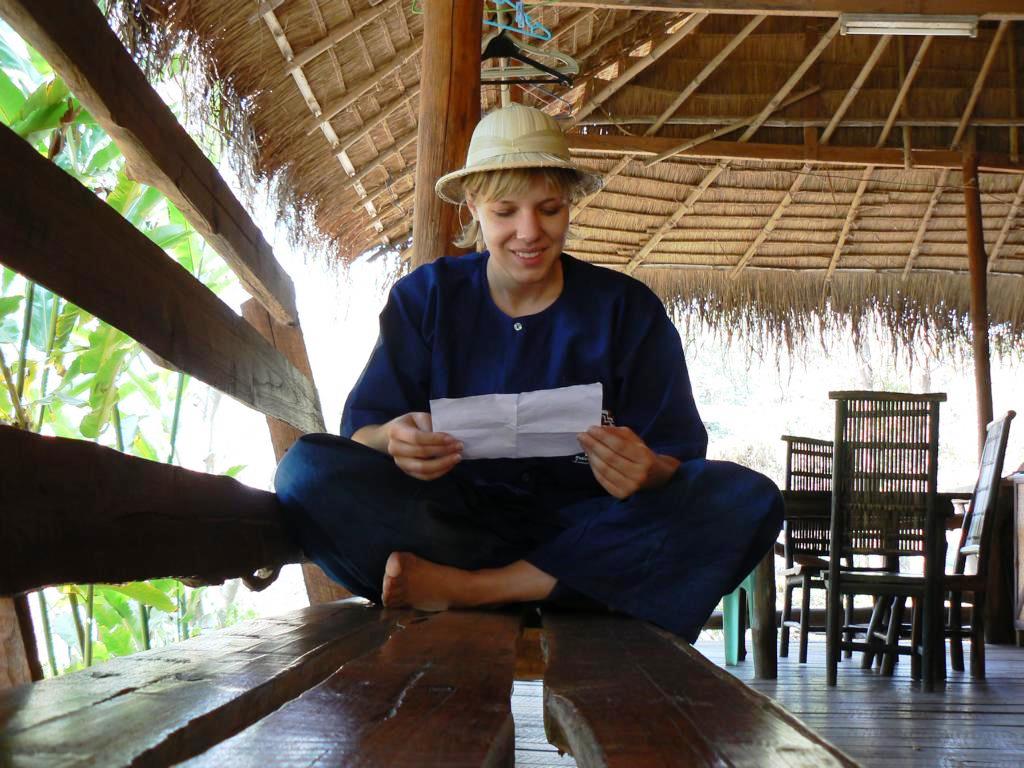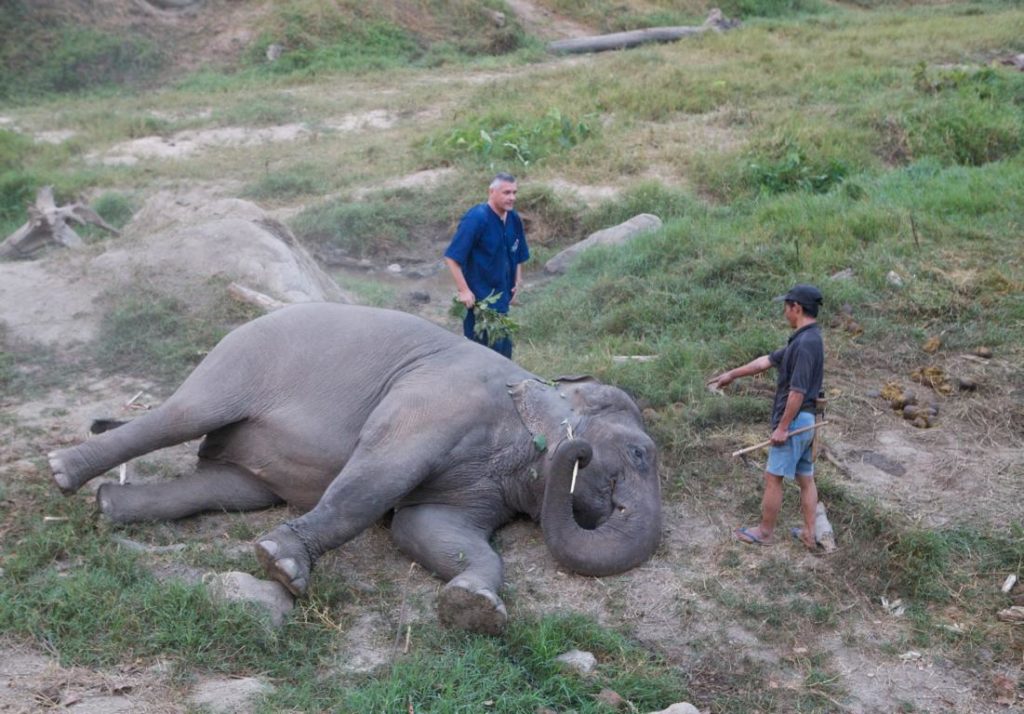The National Elephant Institute of the Forest Industry Organization of Thailand conducted mahout training for amateurs near Lampang. This institute was initially established as a training center for elephants working in the timber industry, where they learned how to lift, handle, and transport heavy logs with their handlers, known as “mahouts” in South- and Southeast Asia. When I took the course with my daughter in 2010, we noticed that the number of timber handling trainings was decreasing while mahout courses for amateurs were increasing. Although there were daily elephant shows for tourists, the facility remained focused on training elephants and mahouts. However, as of 2023, the place has been transformed into “The Elephant Conservation Center” and is now a popular tourist destination.
Going back in time until 2010


Upon our arrival at the training center, we trainees received a place in the guesthouse where we slept on straw mats. And after that, each trainee was assigned an elephant and his mahout. These mahouts are true professionals who live their entire lives with their elephants. Typically, they take charge of a baby elephant when it is around 1.5 years old, and they are usually in their teenage years. Since the average lifespan of an Asian elephant is about 65 years, the mahout and the elephant will spend their entire lives together. My mahout was a gentle Karen; his elephant was a 35-year-old cow in her prime.
Training elements of the Mahout course
Learning the commands
Initially, we were required to learn a few essential commands in Thai language, which included “Go!”, “Stop!”, “Lift your foot!”, “Bow down your head!”, “Pick up the Hook!”, “Lay down!”, and “Stay up!”. Pronunciation was critical, and the non-native speakers were required to practice the commands repeatedly. The most effortless command was “Go!” which is written as ไป and pronounced as ‘Pai’ with a falling tone at the end. The correct tone for pronunciation can be found on the webpage linked here.
Mounting an elephant

There are two primary methods of mounting an elephant. One involves commanding the elephant to lift its right foot so the rider can step on its leg. The other consists of commanding the elephant to lie down, climb onto its neck, and stand up again. Both methods may seem simple, but they are not. An elephant is a massive animal, and mounting it requires skill and experience.


Picking up the bullhook

When riding on the elephant’s neck, the elephant must be trained to pick up the bullhook from the ground if it falls. The bullhook is a signature tool used by mahouts throughout South- and Southeast Asia. It consists of a wooden handle with a metal pick, which is used in Thailand to support verbal commands by pulling on the elephant’s ears in various places. In Thailand, the bullhook is never used to penetrate the skin or inflict pain on the elephant.


However, our personal experiences in India were quite different. There, we witnessed mahouts using the bullhook to jab the upper head area of riding elephants without considering the animal’s welfare. It was heartbreaking to witness such mistreatment and cruelty. We must also acknowledge our role in contributing to this by taking rides with them in the first place. In our opinion, improving the ethical treatment of elephants in some areas of India is imperative.
Getting down from the elephant


Getting down from the elephant is a relatively more straightforward task. One can do it by sliding down on one side and making a final jump to the ground. Alternatively, a more graceful method is to instruct the elephant to bow down its head, allowing the rider to safely slide down over it and reach the ground.
Riding procedures

When riding an elephant, wearing sandals or going barefoot is necessary because the toes on the rider’s feet are used to tickle the ear base at the temporal region in various ways.
Here are some commands and corresponding actions that must be given to the elephant using the rider’s feet and bullhook:
- On the command “Pai”, the rider’s feet push gently and simultaneously towards the backside of the ear base, and the elephant will start walking.
- If the elephant is supposed to walk faster, both feet will rub with their toes up and down the ear base. The speed of the elephant’s walk will depend on the speed of this up-and-down rubbing action of the toes.
- To turn left, the right foot pushes gently into the right ear base while the bullhook pulls on the left ear. The procedure is the same for turning to the right side and vice versa.
- One ear is pulled back with the bullhook to signal the elephant to stop while giving the command “How”.

“Pulling on an ear” always means hooking into the upper ear base where the ear meets the head. Although elephants are rough animals, they are also very sensitive. The bullhook is necessary to communicate with them, but every effort should be made to avoid causing any pain. Therefore, “hooking” in this context means never causing pain to the animal.
The backside of an elephant’s ears is very sensitive, as the ears serve to cool the animal down. Therefore, blood vessels are located very high up at the skin surface. Every three hours, the entire blood content of an elephant flows through its ears, cooling the blood temperature down by about 2 degrees Celsius.
Washing and bathing elephants

Elephants enjoy a full bath in the late afternoon, sometimes even lying entirely in the water.

The mahout and trainee then struggle to stay dry on top of an animal’s moving and rolling mass. However, the difficulty provided great fun for all three of us.

If another elephant is present, they may blow water on each other, which can be easily triggered by a pull with the hook. For the Karen trainer and the author, the daily bath was the best way to strengthen their friendship.
Nightly outing
All of our elephants spent the night together on a meadow about 2 km away from the camp, surrounded by forests. After bathing, we rode on them out there and chained the elephants to iron stakes, each approximately 10 meters long. The elephants had access to flowing water and green grass and were chained at different places daily. Furthermore, every elephant was kept away from others by a distance of at least 200 meters in circumference.

I also learned why the Karen people used mostly female elephants as working elephants. Females can bear offspring, which can be sold for a reasonable price, and they will not go into musth. Musth is a condition in male elephants where hormones take over, and they become crazy and dangerous towards people. Males in musth have to be securely chained on all four legs in a location deep inside the forest, far away from other elephants with enough natural water. Their mahouts feed them, but even they fear them a lot when feeding.
Picking up the elephants in the morning

Mahouts and trainees had to wake up at 4 a.m. without time for their usual morning rituals. As soon as we got up, we had to cut two stalks of ripe sugarcane (Saccharum officinarum) in a nearby field and remove the leaves. Then we were walking in darkness with the sugarcane stalks to our elephants. They were checked to see if everything was fine and fed with the breakfast stalks. This acted like a start-up button.

After the sugar entered their system, they became highly attentive and followed every verbal command immediately. After brushing them to remove dust, we wrapped the chain around their front body and then rode them home.
Participating in Elephant Shows
On the third and fourth day, my daughter and I actively participated in the daily elephant shows alongside our professional mahouts. While everything went smoothly and fine, it was a bit uncomfortable to sit on an elephant that was begging tourists for bananas or pieces of sugarcane.
Graduation Day

On the final day, we had to demonstrate our newly acquired skills once again and were then presented with a ‘Certificate of Appreciation’, which I jokingly refer to as the ‘Elephant Driving License’.


Lessons learned at the Mahout training camp near Lampang:
- The Karen Hill tribe community has been taming and raising elephants for many generations. This makes them the most highly regarded Mahouts in Thailand.
- As part of their training, amateur mahout trainees must become proficient in several Thai language commands.
- Elephants are incredibly perceptive animals and can detect and interpret even slight changes in movement behind their ears.
- Acquiring practical riding skills on elephants is relatively straightforward, as professional mahouts can intervene and correct questionable commands.
.





